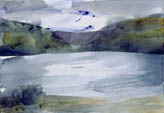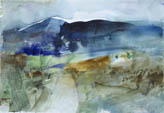exhibition programme | paintings | tapestries | prints | chronology of a life | market | biography & bibliography | agents | news
1987. Landscape (1987-1994)
The artist's regular visits to the Beara Peninsula revive his interest in watercolour landscapes. He explains: 'Ever since I became a painter some fifty years ago, excited by the very smell of oil paint, I've been equally drawn to watercolour, Quite apart from these small landscapes, I have painted very many more head images in watercolour than in oil. Watercolour has taught me much in regard to painting in oil. It has helped me to release myself ...both painter and viewer are constricted by the known appearance and identity of the human individual. Watercolour somehow loosens the knot of identity, while landscape frees you of all such constriction. I do not, myself, believe in artistic creation. In art as in science, I believe in discovery. Discovery, you might say, is revelation through accident, and no art form provides more opportunity for accident than watercolour.'266 Yvonne Scott observes: 'The watercolour landscapes have a particular place in his oeuvre. These are primarily understood as personal rather than mainstream works. As he has explained: "these were always made to one side of the more problematic work which preoccupied me, so that I have tended to think of them as a diversion, the exploration of a private avenue". The landscape paintings are, nonetheless, very significant. During the late 1980s and early 1990s, le Brocquy produced a series of works addressing locations in various parts of the country, primarily Beara, Wicklow and Dublin. These are not the incidental painted sketches of a transient visitor, but considered responses to places he knows well, or whose experience has a special meaning for him ... The artist is clear about his exploration of the topography of landscape which he intentionally transforms from objective description to subjective response. This process, he explains, is not so much "creation" as "discovery" - the uncovering of the essence of a place, and its experience.'267 Prompted on his working procedure, the artist says: 'When I paint images of the head I never have the person before me. Somehow that would impede all imaginative freedom. I prefer to use photographs and recollection. So it is with landscape. I don't paint directly out of doors. The watercolours, like the oils, are painted in the studio - or wherever I happen to be staying. Before working on a watercolour I try to allow myself to become still. The painting itself emerges spontaneously, vaguely prompted by the photograph or sketch before me. I try neither to impose nor copy, but to stay on the lookout for what may happen. Accident is important. In it lies discovery, so I encourage this. Sometimes I dab blotches of clear water over the white surface at random, so that later strokes of colour may run unpredictably here and there. In other works, the lower part of the paper is brush-wetted so that the clear horizon line of a hill may melt downwards into the atmospheric complexities of the landscape below it. This is all a game of sorts, but it is not a trick. A trick is predictable while these methods are conceived expressly to lose control, to open out further possibilities of accidental discovery.'268 The artist's interest in watercolour landscapes originates in the 1940's with The Round O (Meath Tumulus (1942), The Dodder. The White House on the Fall (1943). In 1944 the artist discovers the Western Seaboard in 1944, through his friends Ernie O'Malley in Mayo, Desmond Williams in Connemara, and his colleague, Derek Hill in Achill, thence to Clare Island, home of the Elizabethan queen, Gráinne Umhaill. Makes numerous sketches and watercolours, including Nightfall on a Connemara Bog; Bog Stones, Connemara; Stones, McDara' Island, Drying Kelp. James White notes: 'Ireland had its effect upon his vision, as well as upon his consciousness ... The curiously liquid light of the West of Ireland affected Louis le Brocquy's whole vision, and its influence can still be seen in his love for greenish shades, in his soft colouring and in a certain haziness which, in water-colour especially, tones down all his contrasts.'268bis Earnán O'Malley writes in Horizon: 'Louis le Brocquy wandered through Connemara, a gaunt, ragged district of mountain form, freckled lakes, broken bouldered slopes bedazzled with light and serrated with an edge of sea. The sense of formal composition and defined pattern met with in French landscape and elsewhere is seldom seen here. Harsh light, which strongly emphasises form and structure, is absent also. Instead there is an untamed country lacking in pattern, whose informality makes it easier for people and their world to dovetail and create a mood, and whose elusive colours merge and orchestrate in atmospheric softness. For le Brocquy, as for others, the land was an absorbing challenge, which for a time replaced continental conceptions of paint craft, and demanded expression in a personal idiom.'268bisb Paints Inis More, Clew Bay, Co Mayo (1946), one of a number of small watercolour and ink works made while visiting Earnán O'Malley in the West of Ireland. According to James Adam: 'The piece is evocative of the unique landscape and climate of the west in its apparent spontaneity and its rustic naturalistic colouring. Two similar landscapes and two landscapes with figures dating to the same year are in the Irish American Cultural Institute's O'Malley Collection, which is on long term loan to the University of Limerick.'268bisbb Paints Slieve Mor, Dooagh, Achill (1946) Annamoe River, Co. Wicklow (1947), Sketch Near Lucan (1948), Provence (morning) (1949), Snow landscape, Wiltshire (1949). The genre, however, is almost entirely abandoned over a thirty-five year period until the emergence of Tuscany (1986; w743A), identified as a visual forerunner to the forthcoming Irish landscape series heralding an important body of work, including The Great Blasket from Inis Mhicileain (1987; w762), Road Through a wood, Tipperary (1987; w763) Near Blessington (1988; w788), Road, Beara (1988; w792), Upper Liffey Near Manor Kilbride (1988; w909), Beara Landscape (1989; w953), Emerald Field, Beara (1990; w1013), Wiclow Landscape with Sugarloaf (1990; w1032), Young Liffey near Sally Gap (1991; w1126), Dhulough Pass, Mayo (1993; w1262), Lough Carra, Mayo (1994; w1299). Exhibition at the Taylor Galleries (December 1987): Louis le Brocquy, Watercolour Landscapes. Kate Robinson writes in the Sunday Tribune: 'Louis le Brocquy's collection of small landscapes shows how watercolour can be manipulated in the hands of a master. Through the abstractions of running paint and the dense mistiness of colour, the personality of Ireland is revealed.'269 Commissioned by Noel Pearson, paints four watercolour studies of Sean Ó Riada for the Ó Riada Retrospective, National Concert Hall, Dublin (April 1987). Commissioned by the Van Gogh Foundation, Arles, contributes Deux images de Van Gogh (1987, A.R. w752A), entered into Homage to Van Gogh. International Artists pay tribute to a legend (Japanese tour) alongside works by Bacon, Hockney, Lichtenstein, Johns, Rauschenberg, etc. Exhibition at the Guinness Hop Store, Dublin (September 1987); Ulster Museum, Belfast (November 1987); Festival Centre, Adelaide (March 1978); Westpac Gallery, Melbourne (May 1978); Museum of Contemporary Art, Brisbane (July 1988): Louis le Brocquy, Images, 1975-1987, sixty-eight works, including portrait heads of Yeats, Joyce, Lorca, Picasso, Beckett, Bacon. The philosopher Richard Kearney writes in the exhibition catalogue: 'Clearly there is no direct analogy between Warhol's serigraphs of commodity images like Campbell Soup cans or Marilyn Monroe faces and le Brocquy's multiple series of artist's heads. Le Brocquy is concerned with the archaeological exploration of the hidden spirit of these artists whereas Warhol is playing with the idea that technologically reproducible media images can be pressured into significance by simultaneous repetition and surface imitation. But comparison is not entirely impertinent at the level of form. Both le Brocquy and Warhol are responding instinctively to the postmodern discovery (made in structuralist and post-structuralist theories of language) that signs do not refer to objects in any fixed or determinate manner. Using familiar images - such as Marilyn or Joyce - in such a way that the viewer is compelled to question the rapport between such images and their originals, artists as widely different as le Brocquy and Warhol are undermining our inherited assumptions about representation. By reproducing an almost random series of images, these artists decompose the Renaissance and indeed Romantic cult of an authentic original. Or to put it in another way, the relationship between image and reality, copy and model, is rendered undecidable. Disinherited of our certainties and dispossessed of our convenient assumptions about perception, we the viewers of such serial images no longer look in the same way. We are exposed to otherness. We see otherwise.'270 The exhibition is opened by An Taoiseach Charles J. Haughey, T.D. On this occasion le Brocquy pleads for the nation to be given a National Museum of Modern Art. The Taoiseach responds affirmatively. The Irish Museum of Modern Art will be established by the Government of Ireland three years later as Ireland's first national institution for the presentation and collection of modern and contemporary art. Le Brocquy will be made a founder Board-Member (1989-94). Included in the celebratory exhibition Painting Since World War II, 'Fifty Years of Collecting: An Anniversary Selection', Guggenheim Museum, New York (November 1987).
266 Louis le Brocquy, 'An Interview with Louis le Brocquy by George Morgan', The Irish Landscape (Kinsale: Gandon Editions 1992) p. 10.
267 Yvonne Scott, 'Painting Ireland. Topographical Views from Glin Castle', William Laffan, ed. (Tralee: Curchill House Press, 2006), p. 91-92.
268 Louis le Brocquy, 'An Interview with Louis le Brocquy by George Morgan', The Irish Landscape (Kinsale: Gandon Editions 1992) p. 9-10.
268bis James White, 'Contemporary Irish Artists (VI): Louis le Brocquy', Envoy, vol. 2, no. 6, (Dublin, May 6, 1950), p. 56.
268bisb Earnán O'Malley, 'Louis le Brocquy', Horizon, Vol. XIV, No. 79 (London, July 1946). Reproduced in Dorothy Walker, Louis le Brocquy (Dublin: Ward River Press 1981; London: Hodder & Stoughton 1982), p. 72.
268bisbb James Adam Salerooms, Irish Art Sale, 26 September 2007.
269 Kate Robinson, The Sunday Tribune (Dublin, December 20 1987).
270 Richard Kearney, 'Janus', exhibition catalogue, Louis le Brocquy, Images, 1975-1987 (Dublin: The Arts Council/An Chomhairle Ealaíon and the Cultural Relations Committee. The Guinness Hop Store (Dublin, September - October 1987). Ulster Museum (Belfast, November - December 1987), Festival Centre (Adelaide, March - April 1988), Westpac Gallery [Per National Gallery of Victoria] (Melbourne, May - June 1988), p.52.
Great Lake, Glendalough, 1991
watercolour, 18 x 26 cm, ARW1069
Road, Beara, Peninsula 1990
watercolour, 18 x 26 cm, ARW1002

